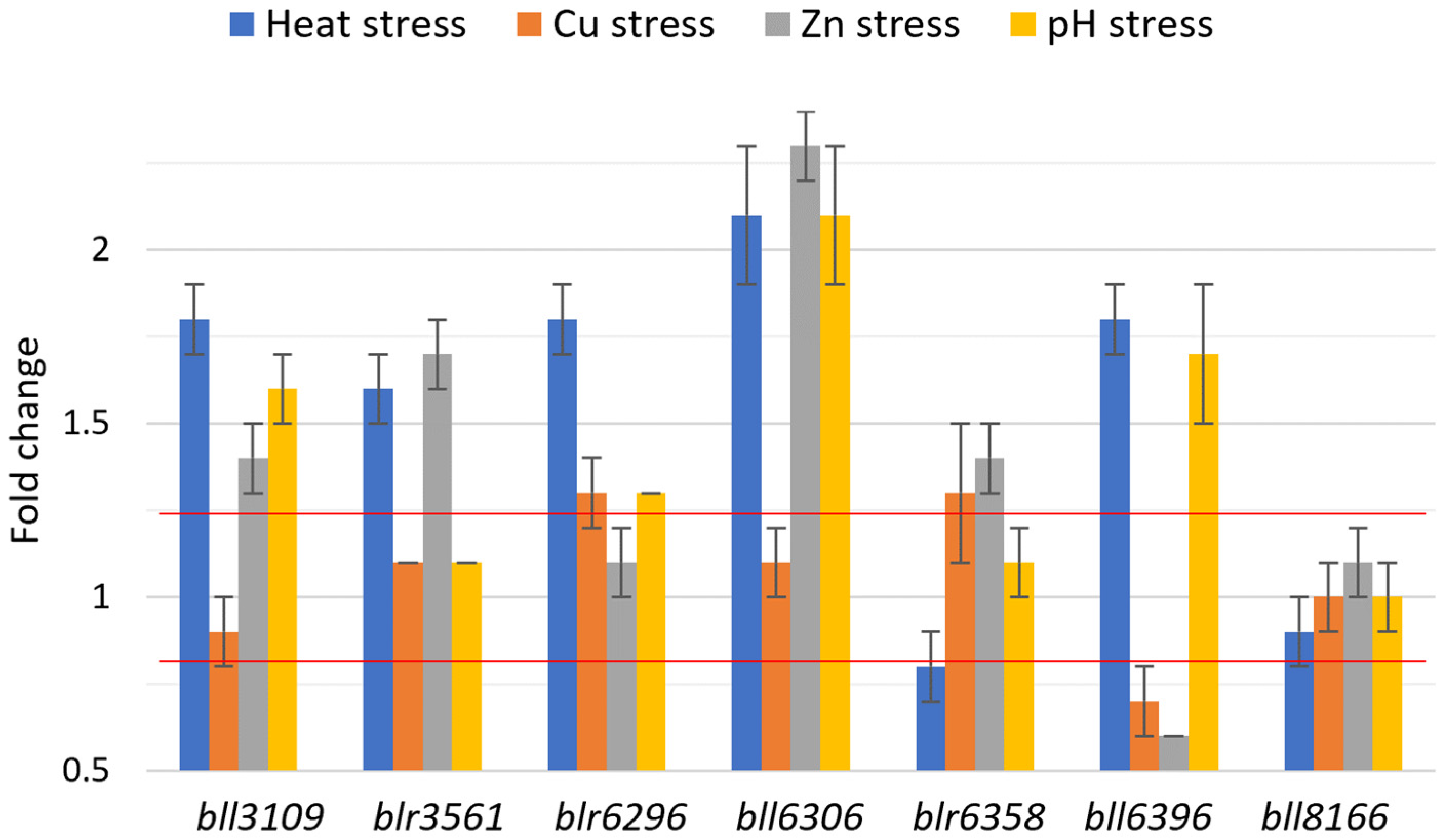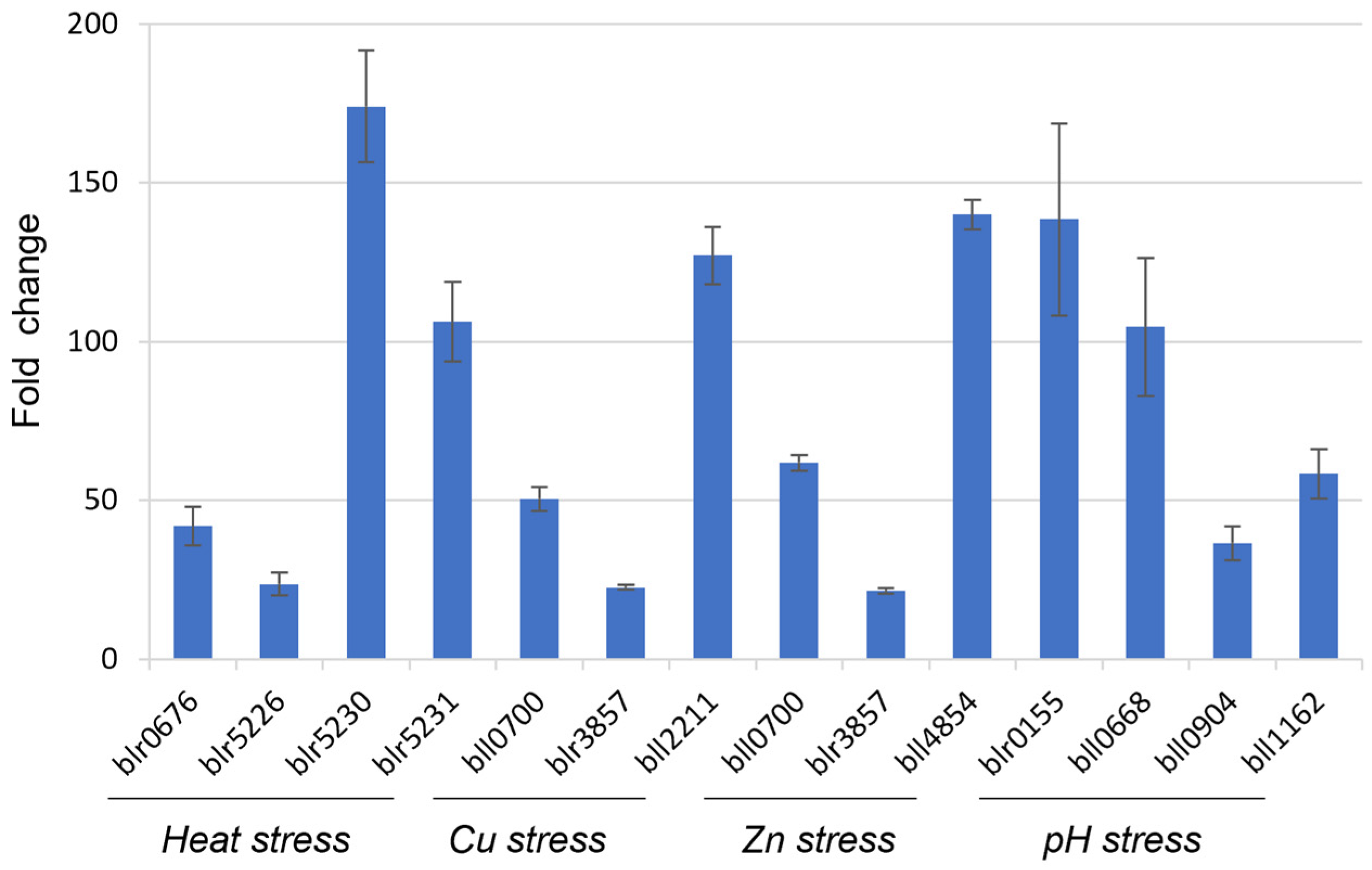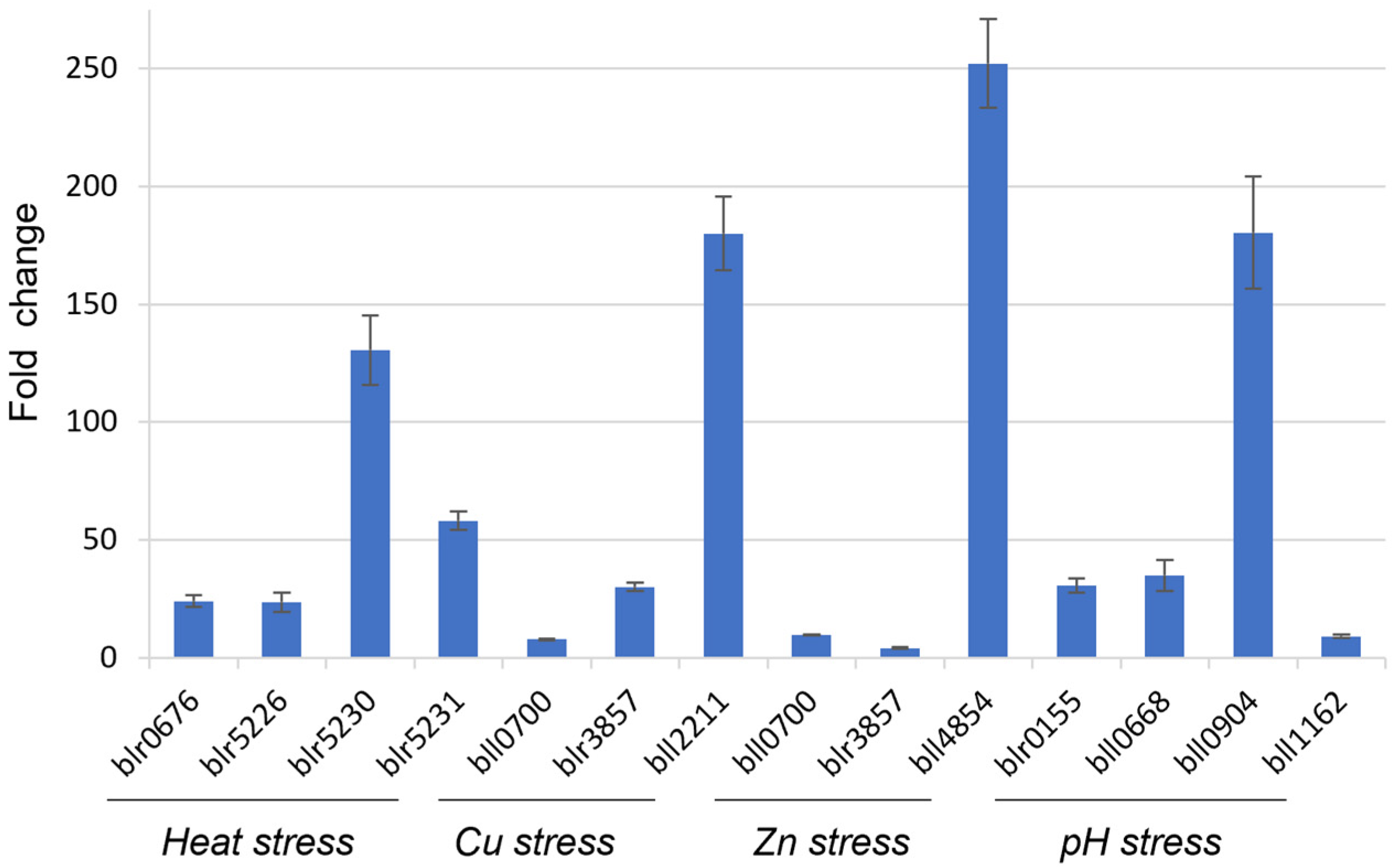Identification and Validation of Reference Genes for Expression Analysis in Nitrogen-Fixing Bacteria under Environmental Stress
Abstract
1. Introduction
2. Materials and Methods
2.1. Bacterial Strain Growth Conditions
2.2. Selection of Candidate Reference Genes
2.3. HKG Homolog Identification
2.4. Heat Shock Analysis
2.5. Heavy Metal Exposure
2.6. pH (Acid) Stress Analysis
2.7. Photosynthetic Bradyrhizobia Temporal Analysis
2.8. RNA Isolation
2.9. qRT-PCR Gene Expression Analysis
2.10. Gene Expression Stability Analyses
3. Results
3.1. Candidate Reference Genes Reflect Typical HKGs
3.2. bll8166 Is the Most Constitutively Expressed Gene under the Environmental Conditions
3.3. bll8166 and blr6358 Serve as Reliable Reference Genes When Measuring Gene Expression under Heat, Heavy Metal, and pH Stresses
3.4. Six Homologs Found in ORS278 and BTAi1
4. Discussion
5. Conclusions
Supplementary Materials
Author Contributions
Funding
Institutional Review Board Statement
Informed Consent Statement
Data Availability Statement
Acknowledgments
Conflicts of Interest
References
- Peoples, M.B.; Herridge, D.F.; Ladha, J.K. Biological Nitrogen Fixation: An Efficient Source of Nitrogen for Sustainable Agricultural Production? Plant Soil 1995, 174, 3–28. [Google Scholar] [CrossRef]
- Crews, T.E.; Peoples, M.B. Legume versus Fertilizer Sources of Nitrogen: Ecological Tradeoffs and Human Needs. Agric. Ecosysts. Environ. 2004, 102, 279–297. [Google Scholar] [CrossRef]
- Zahran, H.H. Rhizobium-Legume Symbiosis and Nitrogen Fixation under Severe Conditions and in an Arid Climate. Microbiol. Mol. Biol. Rev. 1999, 63, 968–989. [Google Scholar] [CrossRef] [PubMed]
- Rodrigues, C.S.; Laranjo, M.; Oliveira, S. Effect of Heat and PH Stress in the Growth of Chickpea Mesorhizobia. Curr. Microbiol. 2006, 53, 1–7. [Google Scholar] [CrossRef][Green Version]
- Cytryn, E.J.; Sangurdekar, D.P.; Streeter, J.G.; Franck, W.L.; Chang, W.; Stacey, G.; Emerich, D.W.; Joshi, T.; Xu, D.; Sadowsky, M.J. Transcriptional and Physiological Responses of Bradyrhizobium japonicum to Desiccation-Induced Stress. J. Bacteriol. 2007, 189, 6751–6762. [Google Scholar] [CrossRef]
- Thaweethawakorn, A.; Parks, D.; So, J.-S.; Chang, W.-S. Role of the Extracytoplasmic Function Sigma Factor CarQ in Oxidative Response of Bradyrhizobium japonicum. J. Microbiol. 2015, 53, 526–534. [Google Scholar] [CrossRef]
- Thellin, O.; Zorzi, W.; Lakaye, B.; De Borman, B.; Coumans, B.; Hennen, G.; Grisar, T.; Igout, A.; Heinen, E. Housekeeping Genes as Internal Standards: Use and Limits. J. Biotechnol. 1999, 75, 291–295. [Google Scholar] [CrossRef]
- Lee, S.; Jo, M.; Lee, J.; Koh, S.S.; Kim, S. Identification of Novel Universal Housekeeping Genes by Statistical Analysis of Microarray Data. J. Biochem. Mol. Biol. 2007, 40, 226–231. [Google Scholar] [CrossRef]
- Warrington, J.A.; Nair, A.; Mahadevappa, M.; Tsyganskaya, M. Comparison of Human Adult and Fetal Expression and Identification of 535 Housekeeping/Maintenance Genes. Physiol. Genom. 2000, 2, 143–147. [Google Scholar] [CrossRef]
- Andersen, C.L.; Jensen, J.L.; Ørntoft, T.F. Normalization of Real-Time Quantitative Reverse Transcription-PCR Data: A Model-Based Variance Estimation Approach to Identify Genes Suited for Normalization, Applied to Bladder and Colon Cancer Data Sets. Cancer Res. 2004, 64, 5245–5250. [Google Scholar] [CrossRef]
- Zhang, L.; Li, W.-H. Mammalian Housekeeping Genes Evolve More Slowly than Tissue-Specific Genes. Mol. Biol. Evol. 2004, 21, 236–239. [Google Scholar] [CrossRef] [PubMed]
- Galisa, P.S.; da Silva, H.A.P.; Macedo, A.V.M.; Reis, V.M.; Vidal, M.S.; Baldani, J.I.; Simões-Araújo, J.L. Identification and Validation of Reference Genes to Study the Gene Expression in Gluconacetobacter diazotrophicus Grown in Different Carbon Sources Using RT-QPCR. J. Microbiol. Methods 2012, 91, 1–7. [Google Scholar] [CrossRef] [PubMed]
- Jain, M.; Nijhawan, A.; Tyagi, A.K.; Khurana, J.P. Validation of Housekeeping Genes as Internal Control for Studying Gene Expression in Rice by Quantitative Real-Time PCR. Biochem. Biophys. Res. Commun. 2006, 345, 646–651. [Google Scholar] [CrossRef]
- Vandesompele, J.; De Preter, K.; Pattyn, F.; Poppe, B.; Van Roy, N.; De Paepe, A.; Speleman, F. Accurate Normalization of Real-Time Quantitative RT-PCR Data by Geometric Averaging of Multiple Internal Control Genes. Genome Biol. 2002, 3, research0034. [Google Scholar] [CrossRef] [PubMed]
- Desroche, N.; Beltramo, C.; Guzzo, J. Determination of an Internal Control to Apply Reverse Transcription Quantitative PCR to Study Stress Response in the Lactic Acid Bacterium Oenococcus oeni. J. Microbiol. Methods 2005, 60, 325–333. [Google Scholar] [CrossRef]
- Dankai, W.; Pongpom, M.; Vanittanakom, N. Validation of Reference Genes for Real-Time Quantitative RT-PCR Studies in Talaromyces marneffei. J. Microbiol. Methods 2015, 118, 42–50. [Google Scholar] [CrossRef]
- McMillan, M.; Pereg, L. Evaluation of Reference Genes for Gene Expression Analysis Using Quantitative RT-PCR in Azospirillum brasilense. PLoS ONE 2014, 9, e98162. [Google Scholar] [CrossRef] [PubMed]
- Cheng, D.; Zhang, Z.; He, X.; Liang, G. Validation of Reference Genes in Solenopsis invicta in Different Developmental Stages, Castes and Tissues. PLoS ONE 2013, 8, e57718. [Google Scholar] [CrossRef]
- Giraud, E.; Moulin, L.; Vallenet, D.; Barbe, V.; Cytryn, E.; Avarre, J.-C.; Jaubert, M.; Simon, D.; Cartieaux, F.; Prin, Y.; et al. Legumes Symbioses: Absence of Nod Genes in Photosynthetic Bradyrhizobia. Science 2007, 316, 1307–1312. [Google Scholar] [CrossRef]
- Beatty, P.H.; Good, A.G. Future Prospects for Cereals That Fix Nitrogen. Science 2011, 333, 416–417. [Google Scholar] [CrossRef]
- Sadowsky, M.J.; Tully, R.E.; Cregan, P.B.; Keyser, H.H. Genetic Diversity in Bradyrhizobium japonicum Serogroup 123 and Its Relation to Genotype-Specific Nodulation of Soybean. Appl. Environ. Microbiol. 1987, 53, 2624–2630. [Google Scholar] [CrossRef] [PubMed]
- Chang, W.-S.; Franck, W.L.; Cytryn, E.; Jeong, S.; Joshi, T.; Emerich, D.W.; Sadowsky, M.J.; Xu, D.; Stacey, G. An Oligonucleotide Microarray Resource for Transcriptional Profiling of Bradyrhizobium japonicum. Mol. Plant Microbe Interact. 2007, 20, 1298–1307. [Google Scholar] [CrossRef] [PubMed]
- Franck, W.L.; Chang, W.-S.; Qiu, J.; Sugawara, M.; Sadowsky, M.J.; Smith, S.A.; Stacey, G. Whole-Genome Transcriptional Profiling of Bradyrhizobium japonicum during Chemoautotrophic Growth. J. Bacteriol. 2008, 190, 6697–6705. [Google Scholar] [CrossRef] [PubMed]
- Jeon, J.-M.; Lee, H.-I.; Donati, A.J.; So, J.-S.; Emerich, D.W.; Chang, W.-S. Whole-Genome Expression Profiling of Bradyrhizobium japonicum in Response to Hydrogen Peroxide. Mol. Plant Microbe Interact. 2011, 24, 1472–1481. [Google Scholar] [CrossRef]
- Donati, A.J.; Lee, H.-I.; Leveau, J.H.J.; Chang, W.-S. Effects of Indole-3-Acetic Acid on the Transcriptional Activities and Stress Tolerance of Bradyrhizobium japonicum. PLoS ONE 2013, 8, e76559. [Google Scholar] [CrossRef]
- Lee, H.-I.; Lee, J.-H.; Park, K.-H.; Sangurdekar, D.; Chang, W.-S. Effect of Soybean Coumestrol on Bradyrhizobium japonicum Nodulation Ability, Biofilm Formation, and Transcriptional Profile. Appl. Environ. Microbiol. 2012, 78, 2896–2903. [Google Scholar] [CrossRef] [PubMed]
- Bowtell, D.; Sambrook, J. DNA Microarrays: A Molecular Cloning Manual; Cold Spring Harbor Laboratory Press: New York, NY, USA, 2003; Volume 79, pp. 101–288. ISBN1 10: 0879696257. ISBN2 13: 9780879696252. [Google Scholar]
- Pfaffl, M.W. A New Mathematical Model for Relative Quantification in Real-Time RT–PCR. Nucleic Acids Res. 2001, 29, e45. [Google Scholar] [CrossRef]
- Silver, N.; Best, S.; Jiang, J.; Thein, S.L. Selection of Housekeeping Genes for Gene Expression Studies in Human Reticulocytes Using Real-Time PCR. BMC Mol. Biol. 2006, 7, 33. [Google Scholar] [CrossRef]
- Waite, R.D.; Papakonstantinopoulou, A.; Littler, E.; Curtis, M.A. Transcriptome Analysis of Pseudomonas aeruginosa Growth: Comparison of Gene Expression in Planktonic Cultures and Developing and Mature Biofilms. J. Bacteriol. 2005, 187, 6571–6576. [Google Scholar] [CrossRef]
- Gaballa, A.; Newton, G.L.; Antelmann, H.; Parsonage, D.; Upton, H.; Rawat, M.; Claiborne, A.; Fahey, R.C.; Helmann, J.D. Biosynthesis and Functions of Bacillithiol, a Major Low-Molecular-Weight Thiol in Bacilli. Proc. Natl. Acad. Sci. USA 2010, 107, 6482–6486. [Google Scholar] [CrossRef]
- Saxena, I.M.; Brown, R.M.; Fevre, M.; Geremia, R.A.; Henrissat, B.; Bacteriol, J.; Saxena, I.M.; Brown, R.M.; Fevre, M.; Geremia, R.A.; et al. Multidomain Architecture of Beta-Glycosyltransferases: Implications for Mechanism of Action. J. Bacteriol. 1995, 177, 1419–1424. [Google Scholar] [CrossRef] [PubMed]
- de Rudder, K.E.; López-Lara, I.M.; Geiger, O. Inactivation of the Gene for Phospholipid N-Methyltransferase in Sinorhizobium meliloti: Phosphatidylcholine Is Required for Normal Growth Mol. Microbiol. 2000, 37, 763–772. [Google Scholar] [CrossRef]
- Abou-Shanab, R.A.I.; van Berkum, P.; Angle, J.S. Heavy Metal Resistance and Genotypic Analysis of Metal Resistance Genes in Gram-Positive and Gram-Negative Bacteria Present in Ni-Rich Serpentine Soil and in the Rhizosphere of Alyssum murale. Chemosphere 2007, 68, 360–367. [Google Scholar] [CrossRef]
- Nies, D.H. Microbial Heavy-Metal Resistance. Appl. Microbiol. Biotechnol. 1999, 51, 730–750. [Google Scholar] [CrossRef]
- Tiwari, R.P.; Reeve, W.G.; Dilworth, M.J.; Glenn, A.R. Acid Tolerance in Rhizobium meliloti Strain WSM419 Involves a Two-Component Sensor-Regulator System. Microbiology 1996, 142, 1693–1704. [Google Scholar] [CrossRef] [PubMed][Green Version]
- Riccillo, P.M.; Muglia, C.I.; de Bruijn, F.J.; Roe, A.J.; Booth, I.R.; Aguilar, O.M. Glutathione Is Involved in Environmental Stress Responses in Rhizobium tropici, Including Acid Tolerance. J. Bacteriol. 2000, 182, 1748–1753. [Google Scholar] [CrossRef] [PubMed]
- Jensen, E.; Hauggaard-Nielsen, H. How Can Increased Use of Biological N2 Fixation in Agriculture Benefit the Environment? Plant Soil 2003, 252, 177–186. [Google Scholar] [CrossRef]
- Guénin, S.; Mauriat, M.; Pelloux, J.; Van Wuytswinkel, O.; Bellini, C.; Gutierrez, L. Normalization of QRT-PCR Data: The Necessity of Adopting a Systematic, Experimental Conditions-Specific, Validation of References. J. Exp. Bot. 2009, 60, 487–493. [Google Scholar] [CrossRef]
- Libault, M.; Thibivilliers, S.; Bilgin, D.D.; Radwan, O.; Benitez, M.; Clough, S.J.; Stacey, G. Identification of Four Soybean Reference Genes for Gene Expression Normalization. Plant Genome 2008, 1, 44–54. [Google Scholar] [CrossRef]
- Mehta, R.; Birerdinc, A.; Hossain, N.; Afendy, A.; Chandhoke, V.; Younossi, Z.; Baranova, A. Validation of Endogenous Reference Genes for QRT-PCR Analysis of Human Visceral Adipose Samples. BMC Mol. Biol. 2010, 11, 39. [Google Scholar] [CrossRef]
- Rivera, L.; López-Patiño, M.A.; Milton, D.L.; Nieto, T.P.; Farto, R. Effective QPCR Methodology to Quantify the Expression of Virulence Genes in Aeromonas salmonicida Subsp. salmonicida. J. Appl. Microbiol. 2015, 118, 792–802. [Google Scholar] [CrossRef] [PubMed]
- Kamitori, S.; Yoshida, H. Structure-Function Relationship of Bacterial SH3 Domains. In SH Domains; Springer: Berlin/Heidelberg, Germany, 2015; pp. 71–89. [Google Scholar] [CrossRef]
- Jordan, D.C. NOTES: Transfer of Rhizobium japonicum Buchanan 1980 to Bradyrhizobium Gen. Nov., a Genus of Slow-Growing, Root Nodule Bacteria from Leguminous Plants. Int. J. Syst. Bacteriol. 1982, 32, 136–139. [Google Scholar] [CrossRef]
- Sauviac, L.; Philippe, H.; Phok, K.; Bruand, C. An Extracytoplasmic Function Sigma Factor Acts as a General Stress Response Regulator in Sinorhizobium meliloti. J. Bacteriol. 2007, 189, 4204–4216. [Google Scholar] [CrossRef]
- Chaudri, A.M.; McGrath, S.P.; Giller, K.E. Survival of the Indigenous Population of Rhizobium leguminosarum Biovar trifolii in Soil Spiked with Cd, Zn, Cu and Ni Salts. Soil Biol. Biochem. 1992, 24, 625–632. [Google Scholar] [CrossRef]
- McGrath, S.P.; Chaudri, A.M.; Giller, K.E. Long-Term Effects of Metals in Sewage Sludge on Soils, Microorganisms and Plants. J. Ind. Microbiol. 1995, 14, 94–104. [Google Scholar] [CrossRef] [PubMed]
- Chaudri, A.M.; Allain, C.M.G.; Barbosa-Jefferson, V.L.; Nicholson, F.A.; Chambers, B.J.; McGrath, S.P. A Study of the Impacts of Zn and Cu on Two Rhizobial Species in Soils of a Long-Term Field Experiment. Plant Soil 2000, 221, 167–179. [Google Scholar] [CrossRef]
- Giller, K.E.; Witter, E.; McGrath, S.P. Toxicity of Heavy Metals to Microorganisms and Microbial Processes in Agricultural Soils: A Review. Soil Biol. Biochem. 1998, 30, 1389–1414. [Google Scholar] [CrossRef]
- Wani, P.A.; Khan, M.S.; Zaidi, A. Effect of Metal Tolerant Plant Growth Promoting Bradyrhizobium Sp. (vigna) on Growth, Symbiosis, Seed Yield and Metal Uptake by Greengram Plants. Chemosphere 2007, 70, 36–45. [Google Scholar] [CrossRef]
- Giller, K.; Witter, E.; Mcgrath, S. Heavy Metals and Soil Microbes. Soil Biol. Biochem. 2009, 41, 2031–2037. [Google Scholar] [CrossRef]
- Graham, P.H.; Draeger, K.J.; Ferrey, M.L.; Conroy, M.J.; Hammer, B.E.; Martinez, E.; Aarons, S.R.; Quinto, C. Acid PH Tolerance in Strains of Rhizobium and Bradyrhizobium, and Initial Studies on the Basis for Acid Tolerance of Rhizobium Tropici UMR1899. Can. J. Microbiol. 1994, 40, 198–207. [Google Scholar] [CrossRef]
- Asanuma, S.; Ayanaba, A. Variation in Acid-al Tolerance of Bradyrhizobium japonicum Strains from African Soils. J. Soil Sci. Plant Nutr. 1990, 36, 309–317. [Google Scholar] [CrossRef]
- Kulkarni, S.; Nautiyal, C.S. Effects of Salt and PH Stress on Temperature-Tolerant Rhizobium Sp. NBRI330 Nodulating Prosopis juliflora. Curr. Microbiol. 2000, 40, 221–226. [Google Scholar] [CrossRef] [PubMed]
- Nautiyal, C.S.; Bhadauria, S.; Kumar, P.; Lal, H.; Mondal, R.; Verma, D. Stress Induced Phosphate Solubilization in Bacteria Isolated from Alkaline Soils. FEMS Microbiol. Lett. 2000, 182, 291–296. [Google Scholar] [CrossRef]
- de Lucena, D.K.; Pühler, A.; Weidner, S. The Role of Sigma Factor RpoH1 in the pH Stress Response of Sinorhizobium meliloti. BMC Microbiol. 2010, 10, 265. [Google Scholar] [CrossRef] [PubMed]



| Gene (Locus Name) | Function |
|---|---|
| bll3109 | putative Ca-binding protein |
| blr3561 | hypothetical protein |
| blr6296 | probable GDP-mannose 6-dehydrogenase |
| bll6306 | probable glycosyl transferase |
| blr6358 | putative oxidoreductase protein |
| bll6396 | putative 2-dehydropantoate 2-reductase |
| bll8166 | probable phospholipid N-methyltransferase |
| Rank | GeNorm a | NormFinder a | Comparative ∆Ct b |
|---|---|---|---|
| 1 | bll8166 (0.882) | bll8166 (0.298) | bll8166 (1.146) |
| 2 | bll6396 (0.907) | blr6296 (0.339) | blr6296 (1.210) |
| 3 | blr6296 (0.928) | bll6396 (0.370) | bl16396 (1.218) |
| 4 | blr6358 (1.014) | blr6358 (0.374) | blr6358 (1.320) |
| 5 | blr3561 (1.064) | blr3561 (0.418) | blr3561 (1.396) |
| 6 | bll6306 (1.183) | bll6306 (0.419) | bll6306 (1.419) |
| 7 | bll3109 (1.243) | bll3109 (0.622) | bll3109 (2.149) |
| Gene Homolog a | Function | Fold Change b |
|---|---|---|
| BRADO7074 (bll3109) | putative virulence factor MviN-like protein | 0.3 ± 0.8 |
| BRADO7042 (bll6306) | putative glycosyl transferase, group 1 | 0.6 ± 0.2 |
| BRADO6535 (blr3561) | hypothetical protein | 0.8 ± 0.3 |
| BRADO0162 (bll8166) | phospholipid N-methyltransferase | 1.0 ± 0.1 |
| BRADO6616 (blr6358) | putative oxioreducatase; putative glucose/ribitol oxioreductase | 1.1 ± 0.0 |
| BRADO3450 (blr6296) | hypothetical protein | 1.6 ± 0.1 |
| Gene Homolog a | Function | Fold Change b |
|---|---|---|
| BBta_4186 (bll3109) | hypothetical protein | 0.6 ± 0.2 |
| BBta_0193 (bll8166) | phospholipid N-methyltransferase | 1.0 ± 0.1 |
| BBta_2283 (blr6358) | putative short-chain dehydrogenase/reductase | 1.0 ± 0.1 |
| BBta_1004 (bll6306) | putative glycosyltransferase, group 1 | 1.2 ± 0.1 |
| BBta_7236 (blr3561) | hypothetical protein | 1.6 ± 0.2 |
| BBta_7353 (blr6296) | UDP-glucose 6-dehydrogenase | 1.6 ± 0.3 |
Publisher’s Note: MDPI stays neutral with regard to jurisdictional claims in published maps and institutional affiliations. |
© 2022 by the authors. Licensee MDPI, Basel, Switzerland. This article is an open access article distributed under the terms and conditions of the Creative Commons Attribution (CC BY) license (https://creativecommons.org/licenses/by/4.0/).
Share and Cite
Parks, D.; Peterson, C.; Chang, W.-S. Identification and Validation of Reference Genes for Expression Analysis in Nitrogen-Fixing Bacteria under Environmental Stress. Life 2022, 12, 1379. https://doi.org/10.3390/life12091379
Parks D, Peterson C, Chang W-S. Identification and Validation of Reference Genes for Expression Analysis in Nitrogen-Fixing Bacteria under Environmental Stress. Life. 2022; 12(9):1379. https://doi.org/10.3390/life12091379
Chicago/Turabian StyleParks, Dylan, Christian Peterson, and Woo-Suk Chang. 2022. "Identification and Validation of Reference Genes for Expression Analysis in Nitrogen-Fixing Bacteria under Environmental Stress" Life 12, no. 9: 1379. https://doi.org/10.3390/life12091379
APA StyleParks, D., Peterson, C., & Chang, W.-S. (2022). Identification and Validation of Reference Genes for Expression Analysis in Nitrogen-Fixing Bacteria under Environmental Stress. Life, 12(9), 1379. https://doi.org/10.3390/life12091379







